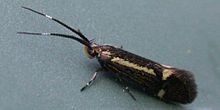|
Esperia sulphurella
Esperia sulphurella, also known as the sulphur tubic, is a species of gelechioid moth in the family Oecophoridae. It is native to Europe, but has been introduced in California.[1]  Adults have a body length of 6–8 millimetres (0.24–0.31 in), and its wingspan is 12–16 millimetres (0.47–0.63 in). The wingspan is between 12 and 16 millimeters. They have a dark brown ground colour. The forewing has a pale yellow marking. The predominantly pale yellow hind wings are dark brown at the tips. At about two-thirds of the length of the antennae, the antennae have a white band. They are on wing in spring.[1] The larvae are black and feed on dead wood.[1] TaxonomyE. sulphurella was first described scientifically by J.C. Fabricius in 1775. Subsequently, the same scientific name was used for several other moths, creating a number of junior homonyms that are all invalid. These include:
References
External linksWikimedia Commons has media related to Esperia sulphurella.
|
||||||||||||||||||||||||||||||
